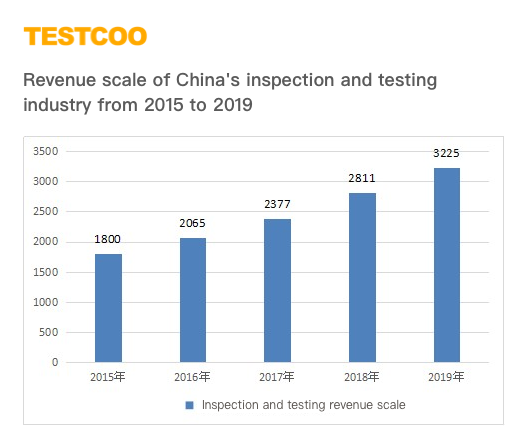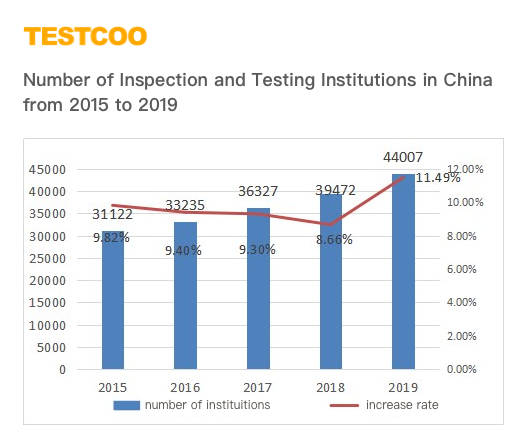Future Certification Inspection and Testing Industry Status and Development Prospects Analysis
The total revenue revenue of our country's monitoring institutions rose from 180 billion yuan in 20135 to 322.5 billion yuan in 2019, and the annual composite growth rate reached 15.69 percent, far more than the global market growth. And the inspection industry has broad application, and as the industrial structure of China is upgraded and the consumption level improves, the testing industry will penetrate into more production and consumption, and the testing industry will be able to develop faster in China in the future as the globalization industry shifts.
China's inspection industry continues to expand, and the number of institutions engaged in all kinds of inspection tests has reached 4,4007, which has increased dramatically compared with 24,847 in 2013. In 2019, the national inspection and testing service scale (the inspection and inspection machine revenue of 10 million yuan and above) inspection and detection agencies, 13.17 percent of the total, and the income of $247.886 billion, a year-on-year increase of 15.36%, showed that our inspection and testing industry was driven by the market mechanism and the combination of the government integration inspection and testing mechanism, and the development trend of intensive development was obvious.
With the liberalization of industry policy and the upgrade of market demand, China's inspection industry has been growing. In recent years, the national identity committee has expanded its openness to private and foreign institutions, simplified the accreditation procedures for certification institutions, and certified accreditation of the inspection.
Due to the increasing demand for the high quality of the product, the scale of the inspection industry in China is continuous increasing. The service scope of China's testing industry has fully covered the entire classification of the national economy industry, and is mainly concentrated in the industry of manufacturing, construction, transportation, warehousing and mail politics, scientific research and technology services, water conservancy industry and environmental and public facilities management industry.
I. Development Trend of China's Certification Inspection and Testing Industry
1. Inspection and testing services will be further market-oriented
China's inspection and testing service industry originated from the supervision of production organization and product quality by administrative control thinking in the planned economy period. The inspection and testing resource allocation and quality infrastructure construction have been managed by the government for a long time.
After entering the market economy, government inspection and testing institutions still dominated the development of inspection and testing services, while other inspection and testing institutions developed slowly. In 2014, a number of government documents such as The Implementation Opinions on the Integration of Inspection, Testing and Certification Institutions (No.8 [2014] of The State Council) were issued, emphasizing the role of the market in the allocation of testing resources, standardizing the market order of the inspection and testing service industry, and effectively promoting the market-oriented reform of the inspection and testing service industry.
Free competition environment is the internal requirement for the further development of inspection and testing service industry. Under the promotion of policy, inspection and testing service industry will be further market-oriented.
2. Third-party inspection and testing services will be further developed and expanded
Compared with inspection and testing institutions subordinate to government departments, third-party inspection and testing service institutions have stronger competitive advantages in equipment update, technical input and service awareness, etc., so third-party inspection and testing service institutions have been continuously growing in recent years.
In March 2015, the former AQSIQ issued the Guidance on The Integration of Inspection and Testing Institutions in the National Quality Inspection System (QSIQ [2015] No. 86), which clearly proposed that the more than 3,500 inspection and testing institutions in the quality inspection system should be divided into two categories: public welfare inspection and testing institutions and operating inspection and testing institutions.
Operating inspection and testing institutions should operate independently, conduct independent accounting and be responsible for their own profits and losses. Under the guidance of market development trend and government policies, government testing institutions will gradually transform, and third-party testing service institutions will further develop and grow.
Ⅱ China Certification Inspection and Testing Development Status
1 certification inspection and testing industry development scale
The testing industry in European and American countries started in the 18th century, and now it has formed a mature market. It was not until 1988 that China's testing industry began to develop. The late start time indicates that China's testing market has not entered the mature stage, and the growth rate is advantageous.
The total revenue of Testing institutions in China increased from 180 billion yuan in 20135 to 322.5 billion yuan in 2019, with a compound annual growth rate of 15.69%, far exceeding the growth rate of the global market. And the testing industry has broad application. With the upgrading of China's industrial structure and the improvement of consumption level, the testing industry will penetrate into more production and consumption fields. In the future, with the global industrial transfer, the testing industry will get faster development in China.


certification inspection and testing industry supply and demand
1) Supply
China's testing industry continues to expand, with the number of institutions engaged in various kinds of inspection and testing reaching 44,007, a significant increase compared with 24,847 in 2013.
In 2019, the national inspection and testing service industry shall be above the scale (this refers to: , inspection and testing machine industry income of 10 million yuan or more) 5795 inspection and testing institutions, accounting for 13.17% of the total number of institutions, the income of 247.886 billion yuan, a year-on-year growth of 15.36%, indicating that China's inspection and testing industry in the market mechanism to promote and government integration of inspection and testing institutions under the double push of policy measures, intensive development trend is obvious.
2) Demand
In 2019, inspection and testing institutions across the country issued about 527 million inspection and testing reports, an increase of 23.13 percent over 2018. Each inspection and testing institution issued 11,970 reports on average, and an average of 1.4432 million reports were issued to the public every day, making positive contributions to strengthening total quality management and improving the quality of enterprises' products and services.
Free Sample Report Performance Quality Control
Download a sample report to keep control of your supply chain!
Featured Articles
 AQL Table | How to Read It
AQL Table | How to Read It TOP 10 Common Defects in Garments Quality Inspection
TOP 10 Common Defects in Garments Quality Inspection Product Packaging and Shipment Label requirements for Amazon FBA
Product Packaging and Shipment Label requirements for Amazon FBA What Is ASTM-F2413-18? Protective Footwear Standard
What Is ASTM-F2413-18? Protective Footwear Standard How to Conduct Third-Party Quality Control Inspections for Electric Scooters
How to Conduct Third-Party Quality Control Inspections for Electric Scooters SMETA Audit-What is SMETA Audit?
SMETA Audit-What is SMETA Audit? TESTCOO Supplier Verification/Certification Service SLCP, Higg FEM, GRS, GOTS
TESTCOO Supplier Verification/Certification Service SLCP, Higg FEM, GRS, GOTS Quality Control Inspection Company in China
Quality Control Inspection Company in China What is Quality Inspection? A Complete Guide
What is Quality Inspection? A Complete Guide Guidelines for Product Inspection in India
Guidelines for Product Inspection in India
Category
- Production Inspection Service
- Factory Audit
- Softline Inspection
- Hardline Inspection
- Electrics Inspection
- Certification
- Checklist
- Manufacturers
- Quality Assurance Basics
- Products Recall
- AQL
- Guidence and Standard
- News
- Supplier Management
- Amazon
- Protective Equipment
- e-commerce quality control
- Indian Manufacturing
- Soft Goods Quality Control
- Supply Chain Management
- Supply Chain Resilience
- E-Commerce Quality Control
- ISO 2859
- Supply Chain Optimization
- Garment Industry
- Higg Index



